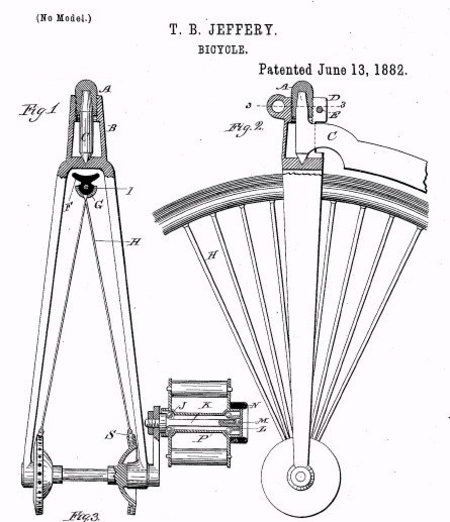G&J Tyres & Patent Wars
Gormully & Jeffery was the second largest American bicycle manufacturer (after Pope), and G&J Tyres was one of the top 19th century tyre companies.
The early days of bicycle manufacture involved fierce competition for patents. Jeffery fought both Selden and Pope, and won. (Selden’s ‘road-locomotive’ patent included any use of an engine in a four-wheeled car).
Colonel Pope had bought Pierre Lallement’s original patent for the bicycle, and aggressively bought all other bicycle patents he could find, amassing a fortune by restricting the types of bicycles other American manufacturers could make and charging them royalties.

1882 G&J CLINCHER TYRE
The Dunlop pneumatic tyre was very basic. It was tubular in shape, secured to a bike rim by glue, with air pressure pressing it against the rim. Rims were wooden, and had a concave surface for receiving the tube. These tyres often came off the rims, and a more secure type of tyre was needed. Thomas B. Jeffery had obtained a patent on the first clincher tyre in 1882 (see patent diagram above). He came up with an improved tyre that was held on by a wire that was embedded in the rubber of the tire, and the wire could be tightened onto the rim.
Above and below is an example of a G&J clincher rim that has not been drilled for spokes.

Inspired by George Brayton’s mammoth internal combustion engine displayed at Philadelphia’s 1876 Centennial Exposition, George Selden began working on a smaller lighter version, succeeding by 1878 – eight years before the public introduction of the Benz Motorwagen – in producing a one-cylinder version with an enclosed crankshaft with the help of Rochester machinist Frank H. Clement and his assistant William Gomm. He filed for a patent on May 8, 1879. His application included not only the engine but its use in a four-wheeled car. He then filed a series of amendments to his application which stretched out the legal process, resulting in a delay of 16 years before the patent was granted on November 5, 1895.
Originally, people thought of powered vehicles as a medium for racing: it took a while before they realized they could be used for more functional purposes.
Although Selden never actually made a car, his patent was credible. In 1899, he sold the patent rights William C. Whitney, who proposed manufacturing electric-powered taxicabs as the Electric Vehicle Co (EVC) for a royalty of $15 per car with a minimum annual payment of $5,000. Whitney and Selden then worked together to collect royalties from other budding automobile manufacturers. He was initially successful, negotiating a 0.75% royalty on all cars sold by the Association of Licensed Automobile Manufacturers. He began his own car company in Rochester under the name Selden Motor Vehicle Co.
The Ford Motor Co was founded in 1903. Henry Ford and four other car makers resolved to contest the patent infringement suit filed by Selden and EVC. The legal fight lasted eight years, its case generating a record 14,000 pages. The case was heavily publicized in the newspapers of the day, and ended in a victory for Selden. In his decision, the judge wrote that the patent covered any automobile propelled by an engine powered by gasoline vapor. Posting a bond of $350,000, Ford appealed, and on January 10, 1911 won his case based on an argument that the engine used in automobiles was not based on George Brayton’s engine, which Selden had improved upon, but on the Otto engine.
This stunning defeat, with only 1 year left to run on the patent, destroyed Selden’s income stream. But his patent had stretched from 1879 to 1911 and, during that time, covered every motorized four-wheel vehicle, a remarkable achievement in patent law.




